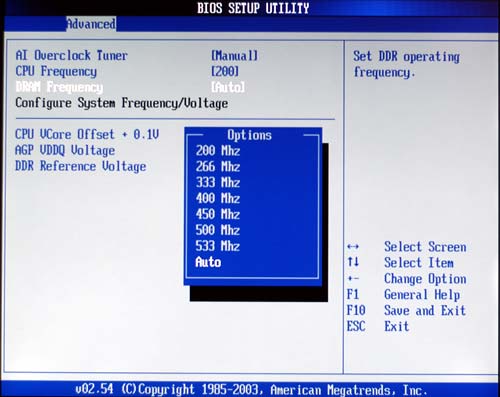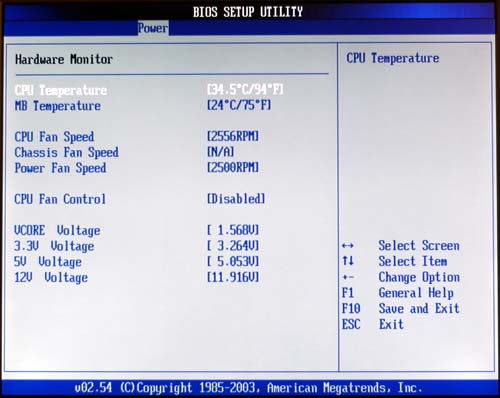Asus P4S800D-E Deluxe & Gigabyte 8S655TX Ultra: SiS 655TX Challenges Intel's Best
by Wesley Fink on December 9, 2003 1:52 PM EST- Posted in
- Motherboards
Asus P4S800D-E: BIOS and Overclocking
Fixed PCI/AGP
SiS provided the ability to fix AGP/PCI in the SiS655, so we expected it to appear as an option on the 655TX. Despite the fact there are no options in the BIOS, there is a PCI/AGP lock on the P4S800D-E — it is always on. Asus states that there is indeed an AGP/PCI lock, despite what you may have heard, and you will see our overclock results confirm that the fixed AGP/PCI is working properly.BIOS

Asus uses AMI BIOS on almost all of their current boards, and the P4S800D-E is no exception. While the layout of the AMI is quite different from the familiar Award layout, it is really easy to use once you get the hang of the logic. Major categories are across the top and each category has many submenus.

Most of the adjustment options we normally use are in the Advanced section.

The “JumperFree Configuration” submenu is where you can adjust CPU Frequency from 100-300, and select from a complete selection of DIMM voltages and AGP voltages. We are accustomed to reduced vCore options on the 800FSB and now Prescott boards, but the only available voltage option is to add +0.1V to the normal voltage. Asus tells us that this will be improved upon in an upcoming BIOS. We will provide more information here when that BIOS update is available.

A wide range of synchronous and asynchronous memory speed options have become a trademark of SiS Intel chipsets. We are happy to report that there are many ratio options available on this Asus. In the “JumperFree” submenu, you will find the ability to set AUTO for memory speed or choose 200, 266, 333, 400, 450, 500, or 533. This range is not as extensive as the Gigabyte board in this review, but it is a lot more than you will find on any Intel-chipset board. Please keep in mind that these settings refer to Base Speed, at a 200 setting of the 800FSB. You are merely starting with this setting or ratio. This means at a setting of 400 and a FSB of 250, you will be running the memory at DDR500. If you start with a 500 memory setting, then a 250FSB setting would mean you are running at DDR625.

Adjustments for memory timings seem to be in an odd place. They are under “Advanced”, “Chipset”, “NorthBridge”. Once you locate them, you will find a complete range of memory timing adjustments.

With a fully loaded system, you could have many bootable devices. That is the purpose of the Boot Menu. Using the options, you can choose which hard drives should be primary boot, and set up the search order for boot devices.

PC Health information is quite complete, but it can be hard to find if you are not familiar with the AMI layout. Look under the Power Menu, “Hardware Monitor” submenu and you will find system temperatures, fan speeds, and voltages.
FSB Overclocking Results
One of the most appealing features of the SiS655-based SINXP was its outstanding overclocking abilities. One of the disappointments of the 655FX was its poor overclocking. We are happy to report that serious SiS overclocking is back with the Asus P4S800D-E! With the initial BIOS supplied by Asus, we found it difficult to boot at any BIOS setting greater than 255 (1020FSB). This is really great performance, but we know of many 2.4 P4 chips that can do 290 or better on a few of the better Intel motherboards. We reported what we had found to Asus who just provided an update, 1001.023 BIOS, which now does 264 with ease into Windows XP at 1:1 ratio, and 267 asynchronously. We were able to boot into DOS at a 280 setting, but the max for XP was 267.| Front Side Bus Overclocking Testbed Default Voltage |
|
| Processor: | Intel Socket 478 3.2 ES |
| CPU Voltage: | 1.55V (default) |
| Cooling: | CoolerMaster IHC-L71 Silent Heat Pipe |
| Power Supply: | Enermax 465W |
| Maximum OC: | 3640 (14x260) and 3484 (13x267) 267FSB |
The above overclocking setup at default voltage allowed us to reach the highest stable FSB of 264 (1056) at 1:1 memory ratio and 267 (1068) asynchronous (5:4). The highest MHz speed with our unlocked ES CPU was achieved at 14x360 or 3.64GHz at default voltage. This is consistent with the performance achieved with this CPU in the top Intel Chipset 865/875 motherboards, and is actually the highest that we have achieved with this ES CPU by a small margin.
The point here is that once again, SiS has a chipset that will not hold back overclocking with most chips. The Asus P4S800D-E will allow almost any 2.6GHz or higher P4 to reach its maximum potential. A good overclocking 2.4 will likely find a 267 setting limiting, but other CPUs will be able to perform at their best in the P4S800D-E. Since Asus was able to improve the maximum overclock with a simple BIOS update, we may also see even better overclocking with future BIOS updates.
For those of you who keep score with memory bandwidth, just a few results will be shared. Sandra 2004 memory benchmarks at 14x260, at 2.5-3-4-7 timings and at 2.75V was 5750 unbuffered, and 3206 unbuffered — results that show convincingly the SiS memory controller in the 655TX to be competitive finally with Intel's excellent 865/875 memory controller.
The memory ratios also allow a few things you simply can't do with an 875/865 chipset. We had no problem running our CPU at 200 (800FSB) while running our DDR500 memory at 500. That is something simply not possible with the ratios available on the 865/875. We never succeeded in running 533 with a 800FSB, but 210 (840) at DDR525 worked fine. We also could do some interesting things in reverse — like run our CPU at 267 (1068) and our memory at DDR400 at tight 2-2-2-6 timings. For owners of 533 processors, we even tried running the CPU at 266 (533) and the memory at DDR400, and it worked just fine. This, again, is something you simply cannot do with an 875/865 chipset board.










24 Comments
View All Comments
FFS - Wednesday, December 10, 2003 - link
Q? to Wesley does these mobos have control of CPU fan speed (again like MSI Neo2), so it run more slow with low CPU load (= more silent)?Another one is how it's compatible with Radeon 9700 Pro? F.e. My SIS648 even with latest SIS-AGP drivers have have a conflict with Hercules R9700Pro when Fast Write is turned on...
Competition is G R E A T E thing,... but you know we also want stability :))) So far, as I know Intel chipsets before were far more stable and compatible with other hardware...
The bottom line "as fast" does not always mean "as good"... :(( And since I also love competition let's hope that SIS655TX as good as 875P.
ripdude - Wednesday, December 10, 2003 - link
A good article on a serie of good boards, I'm very happy you took the P4C800-E dlx in the test.I'm more then happy with the increased competition these boards bring, the P4C800-e dlx is still about 199 in euro land.
SmoiL - Wednesday, December 10, 2003 - link
When is the Asus P4S800D-E coming out? Nada on pricewatchWesley Fink - Wednesday, December 10, 2003 - link
Several of the cells in the Feature Table on page 3 were reversed and have now been corrected.Dual Channel (2x64 bit) is called 128 bit mode on the SiS. The BIOS has the option to run 128-bit (Dual-Channel) mode or to force Dual 64-bit.
FFS - Tuesday, December 9, 2003 - link
Also, as I remember VIA VT6307 support 3 (not 2) 1394a FireWire ports (as on MSI Neo boards), so why Gigabyte would cut them to 2 ???And besides Wesley always trying to stress out color-coded panel connectors.
For me it's more important that you can change RAM without taking off videocard and ASUS had such problems with some of their mobos (now it looks better... but talking about overclocking ... hmmmm.
Even it's damn stable: heatsink on ASUS SiS 655TX is passive (already -) and too close to CPU (plus wrong orientation - same mistake as with original
P4C800 Deluxe. So - NO oversized cooler for CPU on this board.
FFS - Tuesday, December 9, 2003 - link
Realtek ALC658 codec AC '97 2.36-Channel with UAJ Shoud go to Gigabyte and vice versa...
Oh well.., I had my SIS648 for a while and .. so now I'd rather prefer to pay eXtra for board with Intel chipset :((
Plus Gigabit LAN will work faster(=better) with CSA...
FFS - Tuesday, December 9, 2003 - link
Hey guys... In the features table on-board audio codecs are mixed up :)Shalmanese - Tuesday, December 9, 2003 - link
Er, I don't think Sis supports 33Mhz Memory speeds... (pg 5) ;).What happened to the tech support turnaround time bit? That was always the favourite part of your reviews.
Tokelil - Tuesday, December 9, 2003 - link
On page 3 it says its the Gigabyte MB that uses the Marvel Gigabit controller, while on page 4 it says its the asus board that uses the Marvel controller... My guess is it is Asus that uses it and its wrong on page 3.FishTankX - Tuesday, December 9, 2003 - link
What on earth is the difference?There is no commercially avaliable 128 bit DDRSDRAM. All DDRSDRAM is 64 bit.